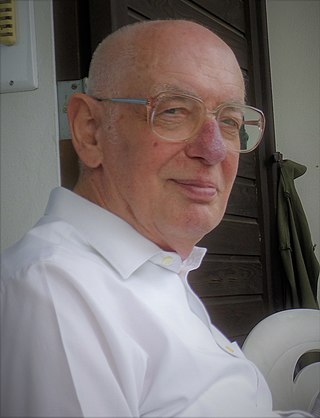Related Research Articles
Gerd Zacher was a German composer, organist, and writer on music. He specialized in contemporary compositions, many of which feature extended techniques, and are written in graphic or verbal scores. He interpreted the scores of numerous contemporary composers, including John Cage, Juan Allende-Blin, Mauricio Kagel, György Ligeti, Hans Otte, Luis de Pablo, and Isang Yun. He is also known as an interpreter of the works of Johann Sebastian Bach.
Klaus Peter Brehmer, was a German painter, graphic artist and filmmaker. From 1971 to 1997 he was professor at the Hochschule für bildende Künste Hamburg.

Friedrich August von Kaulbach was a German portraitist and historical painter.
Walter Blume was a German kapellmeister, music critic, and scholar of Johannes Brahms.
Herbert von Einem was a German art historian.
Rebekka Wolf was a German-Jewish cookbook author. In 1851, she published Kochbuch für israelitische Frauen. It was continuously revised and expanded through 14 editions. The last known edition was published in Frankfurt in 1933.
Hans Theodor Steinbrenner was a German painter and sculptor based in Frankfurt who focused on abstract figures in wood and stone. Many of his works are in public space.
Herzogstraße is a 1.8-kilometer-long street in Munich's Schwabing district. The street's name came from Duke Maximilian Emanuel in Bavaria.
Karl Maria Zwißler was a German conductor, and academic. He was for decades the Generalmusikdirektor and Intendant of the Staatstheater Mainz. He taught conducting at the music universities of Stuttgart and Frankfurt.
Wolfgang Kermer is a German art historian, artist, art educator, author, editor, curator of exhibitions, art collector and professor. From 1971 to 1984 he was repeatedly elected Rector of the State Academy of Fine Arts Stuttgart and thus the first scientific and at the same time youngest teacher in this position in the history of the university. Under his rectorate, the State Academy of Fine Arts Stuttgart was reformed in 1975 and 1978 on the base of two new university laws of the State of Baden-Württemberg and thus, for the first time in its history, authorized to set up diplomas for all courses. One of the accents of his work was the promotion of talented graduates of the academy: In 1978 he organized the first of the so-called ″debutant exhibitions″, an ″unconventional contribution to the promotion of young people″, supported financially by the State of Baden-Württemberg.
Jörn Peter Hiekel is a German musicologist.

Peter Heinz Feist was a German art historian.
Karl Johannes Max Strub was a German violin virtuoso and eminent violin pedagogue. He gained a Europe-wide reputation during his 36 years of activity as primarius of the Strub Quartet. Stations as concertmaster led him from the 1920s to the operas of Stuttgart, Dresden and Berlin. Appointed Germany's youngest music professor at the Hochschule für Musik Franz Liszt, Weimar in 1926, he followed calls to the Berlin University of the Arts and, after the Second World War to the Hochschule für Musik Detmold. Strub was a connoisseur of the classical-romantic repertoire, but also devoted himself to modern music, among others he gave the world premiere of Hindemith's Violin Sonata No. 2 in D major. He promoted the music of Hans Pfitzner. Strub played on a Stradivari violin until 1945; numerous recordings from the 1930s/40s document his work.
Paul Paeschke was a German painter. His work was part of the painting event in the art competition at the 1928 Summer Olympics.
From 1959 to 1989, the city of Leipzig awarded the Kunstpreis der Stadt Leipzig, which was given for outstanding merits in the artistic field to persons who promoted the reputation of the city beyond the region: architects, visual artists, composers, musicians, singers, actors and writers as well as literary and art critics.
Gerhard Eichhorn was a German graphic artist, painter and draughtsman.
Karl Krug was a German painter.
Wolfgang Hütt was a German art historian.

Josef Flossmann was a German sculptor; associated with the Munich Secession.

Raffael Hans Ulrich Schuster-Woldan was a German painter and art professor; associated with the Munich Secession.
References
- ↑ Westermanns Monatshefte , 1972, 113. Jg., Ausgaben 7–12, S. 40 ( Schwabing Art Prize at Google Books).
- ↑ Artis, volume 24. Nienhaus 1972, p. 15 ( , p. 15, at Google Books).
- ↑ Stadt München: Schwabinger Kunstpreis 2011
- ↑ "Doctor Döblingers geschmackvolles KASPERLTHEATER". www.dr-doeblingers-kasperltheater.de. Retrieved 7 November 2021.